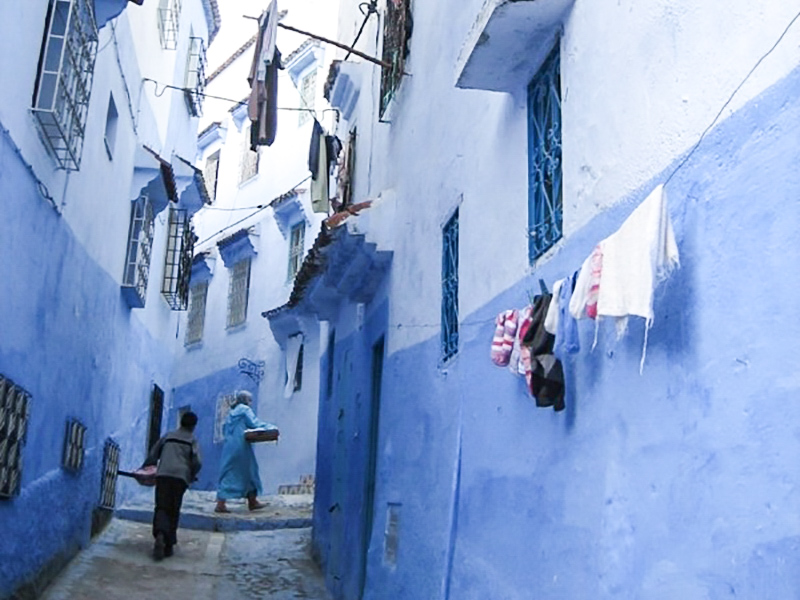Chefchauouen is one of those places you now see all over social media and wonder, is that real?
Nestled among the Rif mountains, home to the Berber tribes, lies Chefchaouen, the Blue Pearl of Morocco. The magical town is known for its iconic shades of blue that accentuate its dramatic setting.
There are many different reasons why it’s painted blue – one of which traces its roots to Jewish and Islamic tradition respectively. In both religions, blue represents peace, safety and the power of heaven. Another theory is that the blue keeps mosquitos away.
Yet another belief, neither romantic or practical, is that it’s a marketing tactic from the 1970s in order to attract more tourists. If that’s the case, they succeeded, especially in the age of social media. Every twist and turn presents a new Instagram-worthy moment.
Just as the call-to-prayer sets a certain tone, so does this infinite palette of blue.
Like most of our travel in Morocco, we arrived in Chefchaouen by bus – from Meknes, it’s a four hour bus ride. At the bus station, we couldn’t help but laugh when a “guide” approached us to show us where the ticket window was located (just 50 steps away). There’s really never a reason to worry about losing your way in Morocco. There are plenty of people to help out (usually for a fee, of course.)
En route to the mountain village, we passed expansive fields of marijuana grown on hashish farms. While the drug has been illegal since Morocco’s independence (1956), it’s among the world’s top producers of hashish and the world’s top supplier of cannabis.
Hashish, or hash as it’s more commonly know, is a cannabis extract created by separating the resin from the buds. Cannabis, also known as marijuana, is the psychoactive drug from the plant of the same name. Throughout Morocco, but specifically in Essaouira and Fes, strangers would approach us offering hash. No doubt they had many takers, particularly among Western tourists.
After settling in at the (unsurprisingly) blue-themed Pension Yasmina, we spent hours wandering the blue washed city.
Literally, everything is blue. Walls. Doors. Steps. In some cases, the robes of local women.
In the afternoon, we enjoyed mint tea served in tall glasses at an outdoor cafe on the main square, Plaza Uta el-Hammam. We watched as locals went about their day: school kids in white lab coats, young adults in modern, western clothes, senior men in druid-like robes. It was fascinating to see these different generations intersecting in the same place.
At one point, we witnessed a mother and son taking baskets of dough to the communal oven for baking. In Morocco, the majority of households don’t have their own ovens. Instead, meals are often cooked in a tajine (a traditional earthenware pot) over a fire.
Using the communal oven (“faraan”) not only saves fuel and time, but also serves as an important social aspect of Moroccan communities. Similar to the laundromats and barber shops of the United States, communal ovens offer a sense of community. Likely a good chance to catch up on the latest gossip too.
One morning, we enjoyed breakfast at Cafe Zbakh, located in an expansive plaza in New Town. Off the beaten path, we were the only tourists there. Men gathered on park benches to catch up– a common sight in Muslim countries, as well as other places, including parts of Europe and Southeast Asia.
While watching kids playing an impromptu game of football, we indulged in hot, steaming crepes served with mounds of butter, goat cheese, and marmalade. Overindulging, we washed it all down with a large cafe au lait each.
Working off breakfast, we ventured further afield and wound up at the far eastern gate of the medina.
Here, we discovered the charming Ras El-Maa “waterfall,” a series of small cascades generated by a spring. While “waterfall” is a generous term in comparison to a site like Iguazu Falls, Brazil, it was worth the wander. We enjoyed the peaceful respite and soaking up the sounds of nature.
Afterwards, we walked a promenade lined with orange trees overlooking quaint homes below. As school kids walked by, we caught a whiff of the sweet citrus smell. It reminded us of Seville, Spain – a destination we’d been before and would be heading back to in a couple of weeks.
Our final night, we headed to Restaurant La Paloma for dinner, a recommendation from the young man at the pension’s front desk. Sitting on the outdoor patio, we enjoyed a set menu over candlelight. Courses included an avocado and shrimp salad, beef tajine, and yes, more crepes – this time, filled with bananas and chocolate.
Like the blue hues of Chefchaouen, the menu was probably catered to tourists. But it made no difference. The life we witnessed going on around us was definitely authentic – from our server to the locals coming and going on the square. Being able to find those pockets of genuine moments, especially within the touristy draw, made it even more special.

